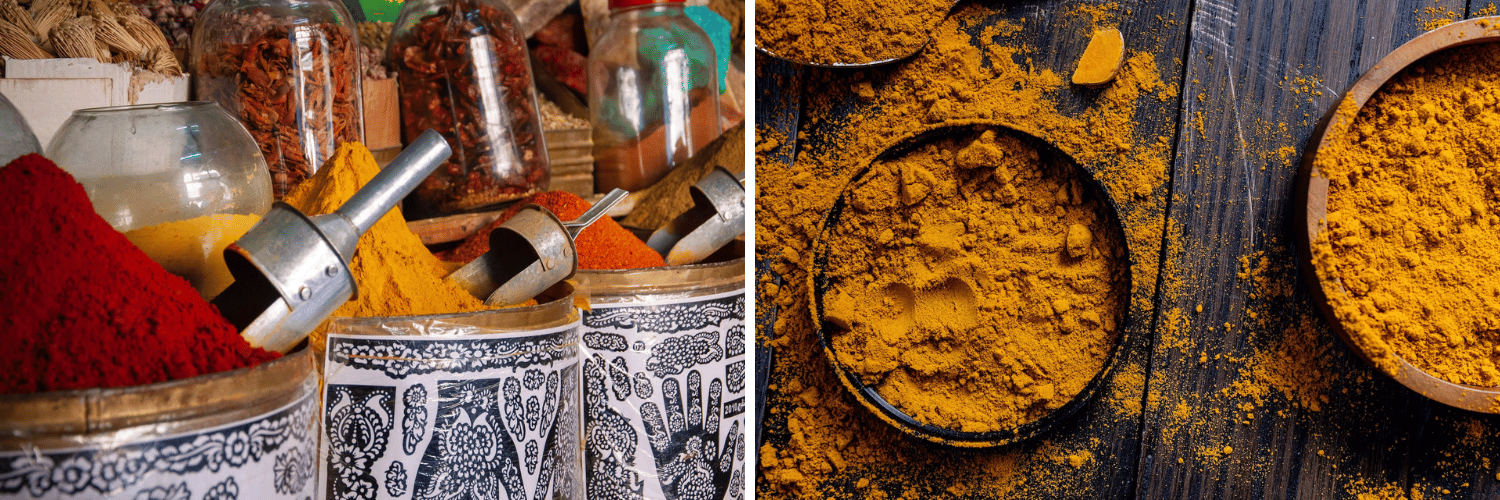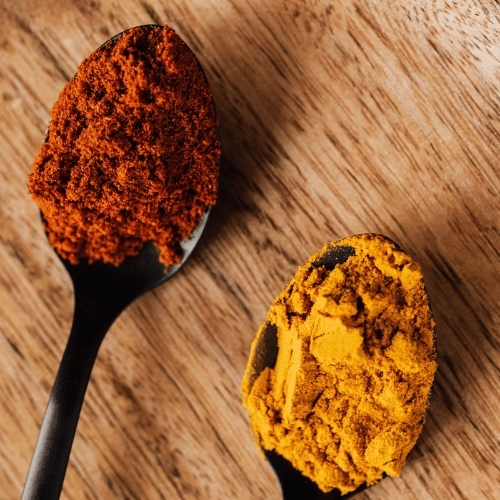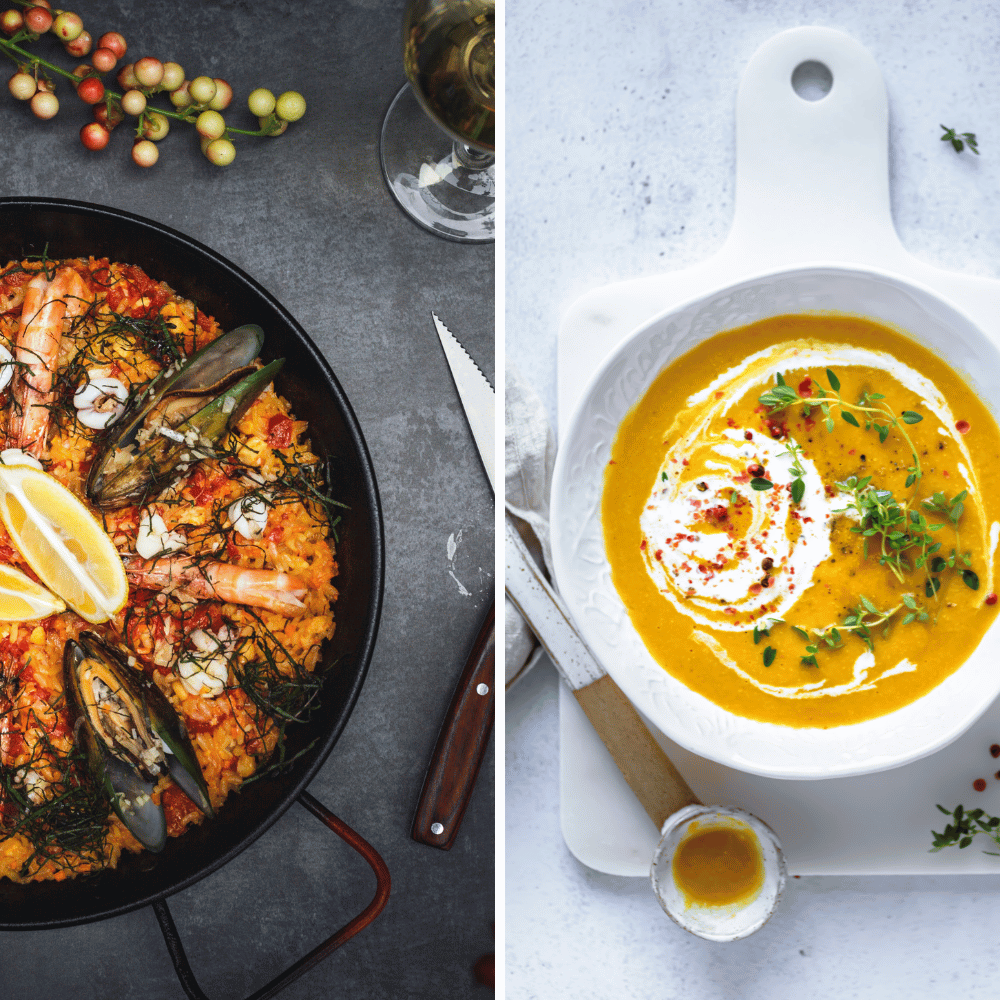Imagine unlocking the secrets of two of the most sought-after spices in the world. Saffron and turmeric, both boasting unique flavors and a plethora of health benefits, have long captivated the culinary and medicinal worlds. But which of these ancient spices reigns supreme in the realm of nutrition and health? Is saffron healthier than turmeric? Join us on a journey through the fascinating world of saffron and turmeric as we uncover their origins, uses, and unrivaled benefits.
Delve into the luxurious nature of saffron and the earthy depth of turmeric, as we compare their nutritional value, medicinal properties, and culinary applications. Discover the potential risks and side effects of these powerful spices, and learn how they can be substituted for each other in recipes while maintaining their distinct characteristics. Let’s embark on this flavorful adventure and uncover which of these spices is truly the healthier option.
Key Takeaways
- Saffron and turmeric offer a variety of vitamins, minerals, antioxidants and health benefits.
- Saffron is more expensive due to its labor-intensive harvesting process but contains higher antioxidant content.
- Consumption should be in moderation as both spices can have potential risks or side effects.
Saffron and Turmeric: A Brief Overview

Saffron, a spice derived from the delicate saffron crocus flower, is renowned for its use in seafood and rice dishes and is often considered the “gold” of the spice world. Its primary constituent, crocin, imbues dishes with a vibrant hue and unique flavor. Turmeric, on the other hand, hails from the curcuma longa plant and is a key ingredient in curry powder. Its active component, curcumin, has potent anti-inflammatory properties. Despite their differing origins, both saffron and turmeric share a slightly bitter flavor, making them popular spices in many cultures.
The scarcity of saffron, which requires only a few threads from each flower to produce, results in a higher price point compared to the more abundant turmeric. Saffron threads are typically harvested by hand, further contributing to its luxurious reputation. Known for its rich kashmiri saffron, golden sardinia saffron, and aromatic sargol saffron varieties, this prized spice has been coveted for centuries.
Turmeric, meanwhile, is widely available and affordable due to its abundance in countries such as India and Indonesia.
Saffron Origins and Uses
The labor-intensive production and unique flavor profile of saffron contribute to its luxurious reputation. Derived from the dried stigmas of the crocus flower, saffron boasts a distinct crimson-red color and a slightly bitter taste. This versatile spice has found its way into Mediterranean and Indian cuisines, traditional medicine, and even as a natural dye.
Spanish saffron, also known as La Mancha or Coupe grade, is the most esteemed and valuable type of saffron. Its deep red color, earthy flavor and intense aroma make it a favorite among saffron connoisseurs. Persian saffron is slightly more bitter but still fragrant, while Indian saffron is typically less costly and milder tasting. For the highest quality, consider organic and natural brands or buying directly from a saffron supplier.
Turmeric Origins and Uses
Belonging to the ginger family, turmeric hails from South India and Indonesia. It has been a staple in cooking and traditional medicine for more than 4,000 years. Known for its:
- anti-inflammatory properties
- antioxidant effects
- potential to improve brain function
- ability to lower the risk of heart disease
- potential to prevent and treat cancer
Turmeric is commonly employed in curry dishes, as well as in sweet dishes in some cultures.
Turmeric is available in various forms, such as fresh turmeric, dried ground turmeric, and turmeric powder capsules. With an estimated 30 varieties that can be cultivated, “Erode” is the most widely grown, while Krishna yields the highest amount per plant. Choosing a natural, organic brand is advisable for guaranteeing the quality and purity of turmeric. This will provide a guaranteed high-quality product.
Nutritional Comparison of Saffron and Turmeric

Both saffron and turmeric provide unique nutritional benefits. They each contain a variety of vitamins and minerals that contribute to overall health. However, due to the small quantities typically consumed, the disparities between their nutritional profiles are largely inconsequential.
Saffron stands out with its high content of magnesium, vitamins B and C, whereas turmeric is rich in iron, copper, vitamins E and K. Though they each provide their own distinct health advantages, incorporating both spices into your diet can yield a range of nutritional benefits.
Vitamins and Minerals
Saffron’s high concentration of magnesium, vitamins B and C make it a valuable addition to any meal. Magnesium has been shown to regulate blood pressure, support healthy bones, and bolster the immune system. On the other hand, turmeric’s wealth of iron, copper, vitamins E and K offer a different array of health benefits. Iron facilitates the transportation of oxygen throughout the body, bolsters the immune system, and assists in the production of energy.
Including both saffron and turmeric in your diet lets you benefit from their unique vitamin and mineral profiles. Whether you’re aiming to improve cardiovascular health or simply add some variety to your meals, these spices offer a wealth of nutritional benefits.
Antioxidants
Packed with powerful antioxidants, both saffron and turmeric play a significant role in fighting oxidative stress and free radicals, potentially leading to chronic illnesses like cancer, heart disease, and diabetes. Saffron’s antioxidants include crocin, crocetin, safranal, and kemperanol, while turmeric boasts curcumin, demethoxycurcumin, and bisdemethoxycurcumin.
Saffron and turmeric are both valuable additions to a health-conscious diet. Here are some key points to consider:
- Saffron has a higher overall antioxidant content, which may give it an edge over turmeric in terms of health benefits.
- Turmeric, on the other hand, has a higher concentration of curcumin, a powerful antioxidant that should not be overlooked.
- Both spices provide valuable antioxidant effects, so incorporating both into your diet can be beneficial.
Health Benefits of Saffron and Turmeric

Saffron and turmeric each offer unique health benefits that make them valuable additions to any diet. Saffron has been suggested to aid in the treatment of depression, PMS, Alzheimer’s disease, and age-related macular degeneration, while turmeric may help address conditions such as arthritis, inflammatory bowel disease, and cancer.
With their distinct health advantages, incorporating both saffron and turmeric into your diet can provide a range of benefits. Whether you’re looking to improve mental well-being, soothe inflammation, or protect against chronic illness, these spices offer impressive potential for promoting overall health.
Anti-Inflammatory Properties
Saffron and turmeric both possess anti-inflammatory properties, which can be beneficial for a variety of health conditions. Turmeric, in particular, has been found to be more effective for inflammation and pain due to its high concentration of curcumin. Saffron, on the other hand, contains compounds such as crocetin, crocins, and other substances that may possess anti-inflammatory properties and act as a therapeutic herbal agent to reduce inflammation and prevent damage caused by free radicals.
Incorporating both saffron and turmeric into your diet allows you to reap the benefits of their anti-inflammatory effects, whether you’re dealing with chronic pain, digestive issues, or simply seeking to improve overall health.
Antioxidant Properties
Turmeric and saffron both contain powerful antioxidants that can help protect against oxidative stress and free radicals that can cause cancer cells to develop.
Saffron’s high concentration of plant compounds such as:
- crocin
- crocetin
- safranal
- kaempferol
provide potent antioxidant effects, while turmeric’s primary active component, curcumin, has also been found to possess strong antioxidant properties.
Adding both saffron and turmeric to your diet can enhance your antioxidant intake, thereby helping to lower the risk of chronic diseases. Embrace the luxurious flavor of saffron and the earthy depth of turmeric to not only enhance your meals but also promote optimal health.
Medicinal Properties
Saffron and turmeric both boast a range of medicinal properties that can help address various health conditions. Saffron’s potential benefits for weight loss, cardiovascular health, and diabetes management have been suggested, while turmeric has been widely studied for its anti-inflammatory, antioxidant, and medicinal properties in addressing conditions such as arthritis, digestive disorders, and cancer.
Including these spices in your diet enables you to leverage their unique medicinal properties, thereby enhancing overall health. From supporting weight loss to promoting heart health, saffron and turmeric offer a wealth of benefits worth exploring.
While incorporating saffron and turmeric into meals can offer some benefits, to truly harness their full therapeutic potential, supplementation is the way to go. When taken in supplement form, you're able to receive a concentrated dose that ensures you're getting the necessary amounts to truly make a difference. It's akin to tapping directly into the heart of their health-boosting properties. Just like with all supplements, it's essential to consult with a healthcare professional to determine the right dosage and to ensure there are no potential interactions with other medications. So, if you're keen on making the most out of what saffron and turmeric have to offer, considering supplementation could be a wise choice for achieving optimal well-being.
On the subject of supplements, you might want to check out two of our past review articles on these two spices. This could save you tons of time in shopping for what we believe to be the best available on Amazon today. Check them out here:
Cooking with Saffron and Turmeric

Saffron and turmeric both offer unique flavors and colors that can elevate a variety of dishes. Saffron’s delicate yet slightly crisp texture makes it perfect for stews, seafood dishes, and risottos, while turmeric’s smooth texture and earthy flavor lend themselves well to curry dishes and rice recipes. With their distinct characteristics, both spices can add depth and complexity to a range of meals.
Culinary experimentation with saffron and turmeric can enrich the flavor and presentation of your dishes while delivering numerous nutritional benefits. Whether you’re looking to add a touch of luxury with saffron or bring warmth and depth with turmeric, these spices are sure to impress in any culinary creation.
Saffron in Cooking
Saffron’s versatility in cooking is truly remarkable, as it can be used in both savory dishes and sweet foods and beverages. Its unique floral taste and vibrant hue make it a popular choice for:
- Paellas
- Stews seafood dishes risotto
- Bouillabaisse
- Desserts, including sweet rice puddings
- Cakes
- Ice creams
- Custards
Saffron is even used to flavor liqueurs, such as saffron-infused gin, adding a luxurious touch to any beverage.
When cooking with saffron, remember that a small amount goes a long way. Just a few threads are needed to impart its distinct flavor and color, making it a valuable addition to any recipe.
Turmeric in Cooking
Turmeric’s earthy, slightly bitter flavor makes it a popular choice for many recipes, especially in Asian and Middle Eastern cuisines. Its rich, golden color adds a visually appealing touch to dishes like curries, soups, and rice dishes, such as biryani. Turmeric is also used to produce pickles, chutneys, and even face masks for a natural radiance.
When using turmeric in cooking, be aware that its distinct flavor can be overpowering in large quantities. Start with a small amount and adjust according to taste, ensuring that its earthy depth complements rather than overwhelms your dish.
Cost and Availability of Saffron and Turmeric
The widespread availability and affordability of turmeric, owing to its abundance, make it a staple in kitchens worldwide. Its cultivation and production in numerous countries, such as India and Indonesia, contribute to its lower cost and widespread availability. Turmeric can be easily found in grocery stores and online retailers in various forms, including pure turmeric powder, capsules, and fresh root.
Saffron, on the other hand, is scarce and expensive due to its specific growing conditions and labor-intensive harvesting process. Each saffron crocus flower yields only three crimson-colored stigmas, which must be hand-harvested, contributing to saffron’s high price point. Despite its high cost, saffron’s unique flavor and impressive health benefits make it a prized addition to any pantry, even when using up to four flowers.
Potential Risks and Side Effects
Despite the numerous health benefits of both saffron and turmeric, it’s critical to be mindful of potential risks and side effects tied to their consumption. Excessive intake of saffron can have serious consequences, including:
- Vomiting
- Decrease in heart rate
- Dizziness
- Lethargy
- Yellowing of the skin
These symptoms could even be fatal. Moderation is key when incorporating saffron into your diet to avoid these potential hazards.
Turmeric, too, can cause side effects when consumed in large amounts. Excessive ingestion may lead to symptoms such as indigestion and nausea. As with saffron, it’s important to practice moderation when using turmeric to ensure you’re reaping its health benefits without putting your well-being at risk.
Substituting Saffron for Turmeric (and vice versa)
Though saffron and turmeric share a hint of bitterness, their unique flavors and hues imply that swapping one for the other in recipes can change the dish’s look and flavor. In some cases, however, saffron and turmeric can be used interchangeably, though it’s important to consider the potential impact on the dish’s flavor profile and visual appeal.
For instance, substituting saffron for turmeric in a recipe may involve using a mixture of ¼ teaspoon turmeric and ¼ teaspoon paprika to replace a ¼ teaspoon (or less) of saffron. Similarly, substituting turmeric for saffron may require a mixture of ¼ teaspoon saffron and ¼ teaspoon paprika to replace a ¼ teaspoon (or less) of turmeric.
Be mindful of the potential changes to your dish and adjust the amounts accordingly to achieve the desired flavor and appearance.
Saffron vs. Turmeric: Which is Healthier?
Even though both saffron and turmeric have unique health benefits, saffron could be deemed healthier due to its superior antioxidant content and broader vitamin and mineral spectrum. If you would like to explore Saffron supplements in greater depth, you should check out this article, published earlier this year:
However, it would be best never to discount the value of incorporating both spices into your diet. The combination can provide a range of nutritional advantages, from improving cardiovascular health to combating inflammation and oxidative stress.
Ultimately, the choice between saffron and turmeric comes down to personal preference and the specific health benefits you seek. By incorporating both spices into your diet, you can enjoy their unique flavors and nutritional profiles, providing a diverse and healthful addition to your meals.
Summary
In conclusion, saffron and turmeric boast unique flavors, nutritional profiles, and health benefits that make them valuable additions to any diet. While saffron is considered a luxury spice due to its scarcity and labor-intensive production, turmeric is widely available and affordable. Both spices can be used in various dishes, offering versatility in the kitchen and many health advantages as supplements.
By incorporating saffron and turmeric into your culinary repertoire, you can enjoy the best of both worlds – the luxurious flavor of saffron and the earthy depth of turmeric while reaping the rewards of their impressive nutritional properties. So why choose one when you can savor the benefits of both?
Frequently Asked Questions
Can I use saffron instead of turmeric?
Turmeric is the best substitute for saffron, as it is a member of the ginger family and provides a similar yellow color when cooked. Ground turmeric is easy to find at your local grocery store and if substituting it for saffron, use less than the recipe calls for so that the dish does not become sweet.
Can I take turmeric and saffron together?
It appears that taking turmeric and saffron together may be beneficial, as many patients have reported an improved sense of wellbeing when they take them both.
What is so special about saffron?
Saffron is a unique spice packed with powerful antioxidants that can potentially offer numerous health benefits, from reducing PMS symptoms to aiding weight loss. Its safety and easy-to-add nature make it a great choice for anyone looking to improve their health.
Which is better for skin saffron or turmeric?
Saffron seems to be the better option for skin health, as it encourages the shedding of old, unhealthy cells so that new and healthy ones can emerge. It is also known to reduce inflammation, which can help to reduce the appearance of wrinkles and other signs of aging.
What is the primary difference between saffron and turmeric?
Saffron is a spice from a flower, while turmeric is a root obtained from a plant.
Thanks for taking this journey with us to explore these two powerful and tasty spices. And, don't forget to check out our review articles on these two spice as well!
And please, come back soon to check out our next review of another awesome supplement – we’re always looking out for YOU!
*We are not qualified medical advisors. The content here is only based on our personal opinions and should NOT be used as a substitute for a healthcare professional's advice!











Member discussion